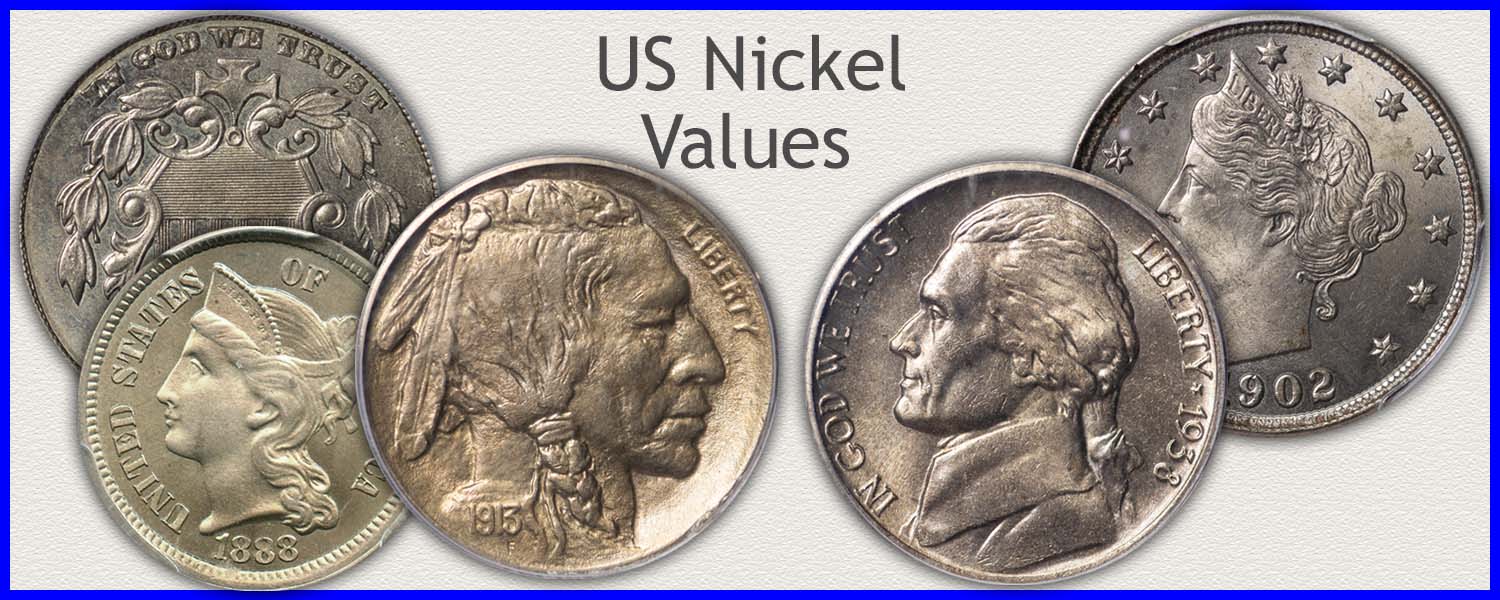Coin Values Moving with Precious Metals: Up-Dated 4/7/2025: Gold $3035 | Silver $30.08
Buffalo Nickel Value
Minted 1913 to 1938; buffalo nickel value is found by determining date | mintmark | condition. A heavily worn coin with a readable date is worth well above face value. A very popular series with collectors, each coin is evaluated closely to identify its full potential. Follow the step by step process below and find where your coin is listed on the value chart.
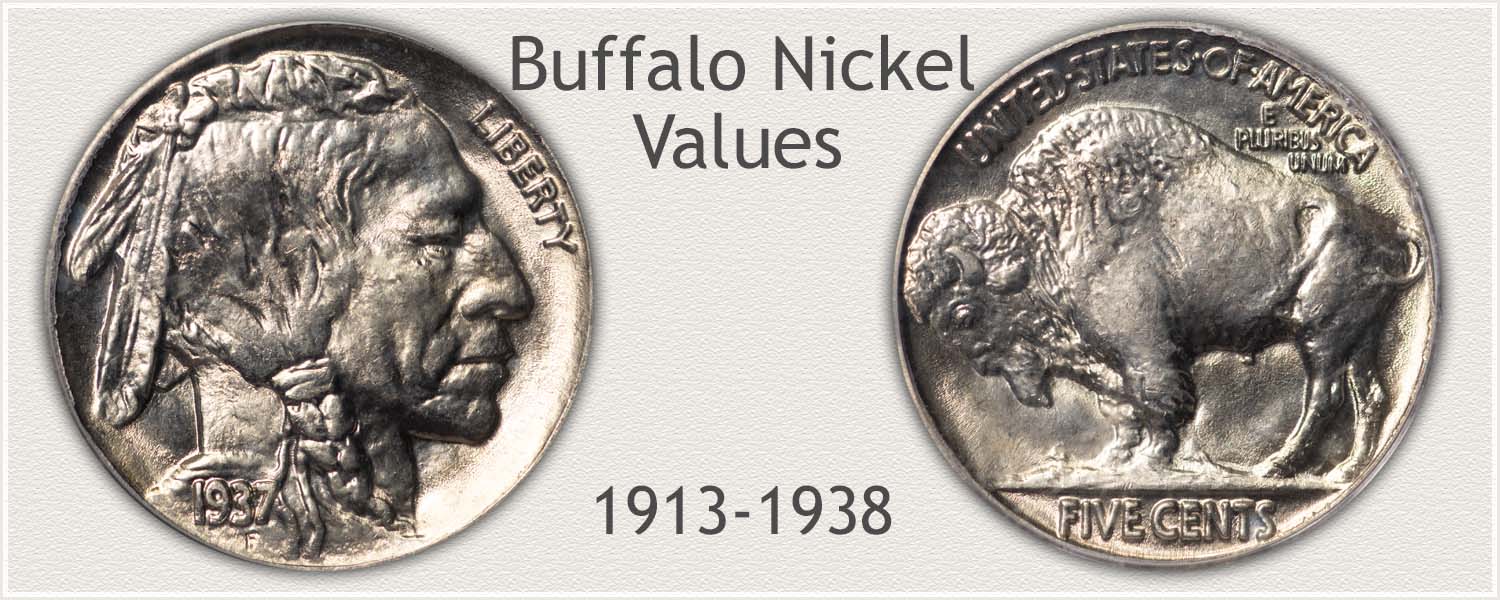
Steps Leading to Value:
- Step 1: Date and Mintmark Combination - Identify date and locate mintmarks to find listing on the value chart.
- Step 2: Grading Condition - Using Video, Images, and Descriptions judge the condition and determine grade.
- Step 3: Special Qualities - Varieties are important to collectors, compare your coin to images to recognize the important qualities to these old buffalo nickels.
The value table shows the importance of the key elements to identify.
| Buffalo Nickel Value 1913 to 1938 | ||||
|---|---|---|---|---|
| Condition of Coin | ||||
| Date | Good | Fine | Extremely Fine | Mint State |
| Buffalo Nickel Value Updated | 2025 | |||
| 1913 Type 1 | $7.80 | $10 | $18 | $28 |
| 1913 D Type 1 | $14 | $20 | $28 | $34 |
| 1913 S Type 1 | $26 | $37 | $54 | $102 |
| 1913 Type 2 | $8 | $12 | $18 | $41 |
| 1913 D Type 2 | $52 | $77 | $105 | $237 |
| 1913 S Type 2 | $117 | $184 | $300 | $587 |
| 1914 | $13 | $18 | $21 | $55 |
| 1914 D | $39 | $72 | $132 | $286 |
| 1914 S | $21 | $29 | $68 | $129 |
| 1915 | $3.21 | $7.58 | $14 | $54 |
| 1915 D | $15 | $28 | $58 | $177 |
| 1915 S | $28 | $59 | $243 | $478 |
| 1916 | $3.03 | $4.98 | $9 | $40 |
| 1916 D | $14 | $18 | $48 | $119 |
| 1916 S | $8.45 | $18 | $51 | $164 |
| 1917 | $2.77 | $5.20 | $9 | $58 |
| 1917 D | $16 | $34 | $93 | $312 |
| 1917 S | $17 | $65 | $131 | $687 |
| 1918 | $3.71 | $5.85 | $16 | $104 |
| 1918/17 D | $516 | $1,313 | RARE | RARE |
| 1918 D | $18 | $46 | $125 | $364 |
| 1918 S | $10 | $40 | $141 | $834 |
| 1919 | $1.73 | $3.64 | $11 | $47 |
| 1919 D | $15 | $51 | $115 | $743 |
| 1919 S | $7.15 | $37 | $137 | $863 |
| 1920 | $1.25 | $3.25 | $10 | $57 |
| 1920 D | $5.96 | $29 | $130 | $507 |
| 1920 S | $2.82 | $24 | $129 | $499 |
| 1921 | $3.14 | $7.37 | $35 | $129 |
| 1921 S | $30 | $73 | $449 | $1,398 |
| 1923 | $1.41 | $3.81 | $15 | $80 |
| 1923 S | $5.42 | $31 | $138 | $494 |
| 1924 | $1.06 | $2 | $17 | $73 |
| 1924 D | $6.72 | $20 | $128 | $450 |
| 1924 S | $15 | $70 | $451 | $2,158 |
| 1925 | $1.78 | $3.25 | $16 | $59 |
| 1925 D | $8 | $27 | $103 | $348 |
| 1925 S | $3.79 | $13 | $98 | $518 |
| 1926 | $0.93 | $1.97 | $10.18 | $54 |
| 1926 D | $8.67 | $23 | $93 | $246 |
| 1926 S | $33 | $55 | $515 | $4,570 |
| 1927 | $0.89 | $1.99 | $9.10 | $42 |
| 1927 D | $1.89 | $8.02 | $56 | $217 |
| 1927 S | $1.73 | $5.85 | $71 | $857 |
| 1928 | $0.89 | $1.78 | $9 | $50 |
| 1928 D | $1.19 | $4.33 | $26 | $68 |
| 1928 S | $1.30 | $4.55 | $21 | $350 |
| 1929 | $0.85 | $1.67 | $8.23 | $41 |
| 1929 D | $1.15 | $2.23 | $25 | $64 |
| 1929 S | $1.06 | $1.73 | $7.80 | $52 |
| 1930 | $0.89 | $1.50 | $8.88 | $28 |
| 1930 S | $0.98 | $2.86 | $11 | $47 |
| 1931 S | $7 | $13 | $23 | $54 |
| 1934 | $0.69 | $1.60 | $8.67 | $30 |
| 1934 D | $1.30 | $3.41 | $15 | $46 |
| 1935 | $0.65 | $1.11 | $3.36 | $24 |
| 1935 D | $0.95 | $1.73 | $14 | $37 |
| 1935 S | $0.78 | $1.39 | $6.83 | $23 |
| 1936 | $0.76 | $1.00 | $2.82 | $15 |
| 1936 D | $0.78 | $1.11 | $4.55 | $33 |
| 1936 S | $0.78 | $1.16 | $3.90 | $23 |
| 1937 | $0.76 | $1.39 | $3.25 | $17 |
| 1937 D | $0.78 | $1.26 | $3.58 | $16 |
| 1937 D 3 Leg | $254 | $391 | $637 | $1,716 |
| 1937 S | $0.78 | $1.54 | $3.25 | $22 |
| 1938 D | $0.95 | $1.73 | $4.20 | $16 |
The above are wholesale coin values. Computed from dealer's price lists with various mark-up factors figured in. They reflect closely the value you would expect to receive when selling.
Variations in value do occur subject to subtle grading points, collector demands and dealer needs.
Step 1: | Date and Mintmark Combination is Identified
Three different mints struck Buffalo nickels throughout the span of the series; 1913 to 1938. In most years all three mints produced nickels. The key is to identify both the date and mint of each coin. Mintmarks on the Denver and San Francisco issues identify the mint. Philadelphia did not place a mintmark on their production.
Collectors typically assemble sets of Buffalo nickels including each mint variety of each year. Availability and scarcity of a year and mintmark combination drives values above minimum base value.
"S" Mintmark on Reverse: San Francisco Mint Struck the Coin
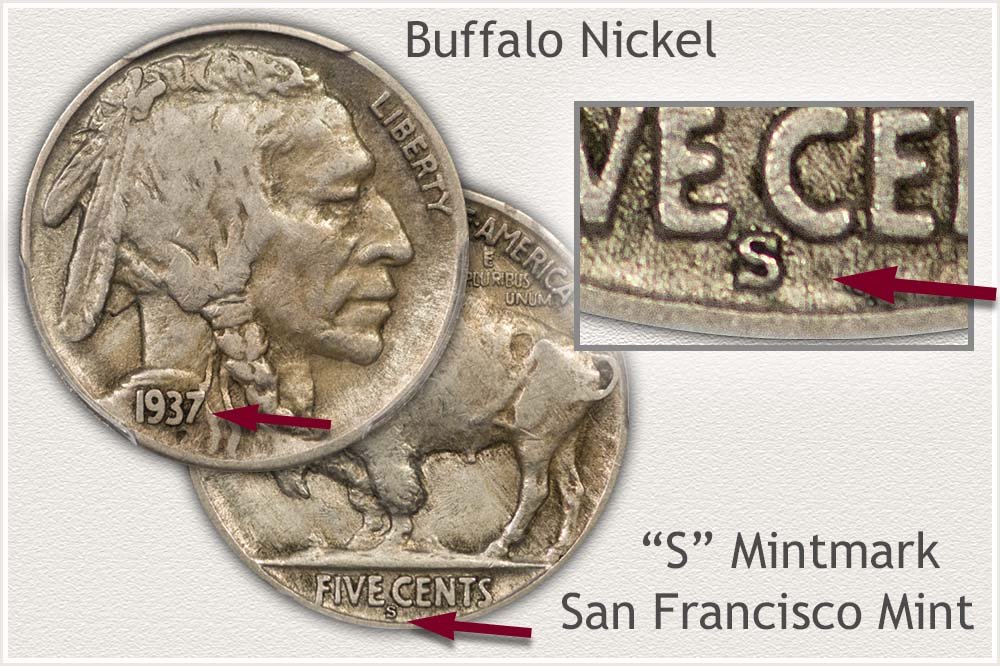
Low mintage numbers of San Francisco Buffalo nickels place most dates as the scarce issue for the year. A total of 118 million were struck with all years combined, lowest of the mints. Many of the key and high value nickels are the San Francisco coins.
San Francisco mint placed a "S" mintmark on the reverse just under Five Cents. A date with all numerals clearly showing plus the "S" mintmark is a premium value nickel.
"D" Mintmark on Reverse: Denver Mint Struck the Coin
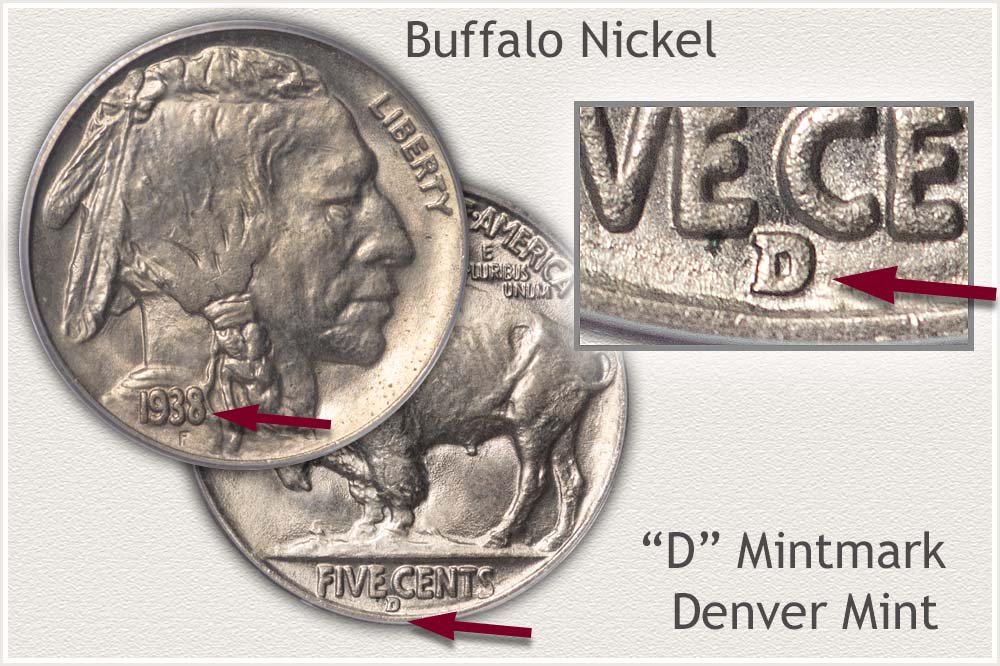
The Denver Mint in Colorado also contributed to the numbers of Buffalo nickels minted. Striking just over 225 million coins, Denver issues are another exciting find. Early year examples 1913 to 1926 are all high premium coins.
Denver placed a "D" mintmark on the reverse to identify its production. A surprising premium coin is the last year of the Buffalo nickel 1938, all were minted at Denver. Last of series plus Denver only adds to this coin's popularity and demand from collectors.
No Mintmark on Reverse: Philadelphia Mint Struck the Coin
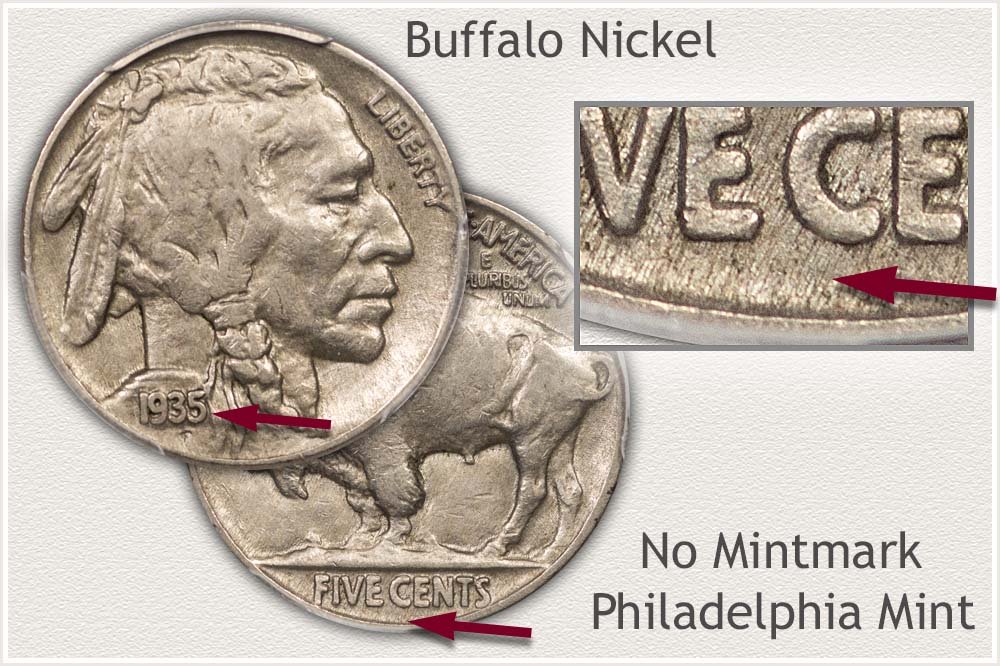
Leading in numbers of Buffalo nickels struck is the Philadelphia mint. Throughout the years the main mint placed over 900 million nickels into circulation. Most of the old nickels found today are the Philadelphia issue. Many collectors find these coins appealing. Affordable in higher condition, a date run is a popular collection, creating a steady demand for all Buffalo nickels.
Looking on the reverse, just under Five Cents; if without a mintmark, the coin was struck at Philadelphia. The Philadelphia mint did not place mintmarks on Buffalo nickels.
Step 2: | Grading Condition of Buffalo Nickels
Coin collecting remains a popular hobby today. A collection of Buffalo nickels presents an engaging pursuit for both young and advanced collectors. Your coins have the potential to add to a collection.
Condition Narrows Value Range
Judging condition directly links to how much your coin is worth. Rare dates and mintmark combinations are a start. Grading narrows into a close value range.
Using a single light source and magnification, first inspect for a clear date. The date area is high in relief on Buffalo nickels and quickly wears. A bold date showing places your coin in the upper grade ranges. Tilting the coin under the light at different angles helps find subtle details. Compare to the grading images, finding the grade closest to the condition of your coin.
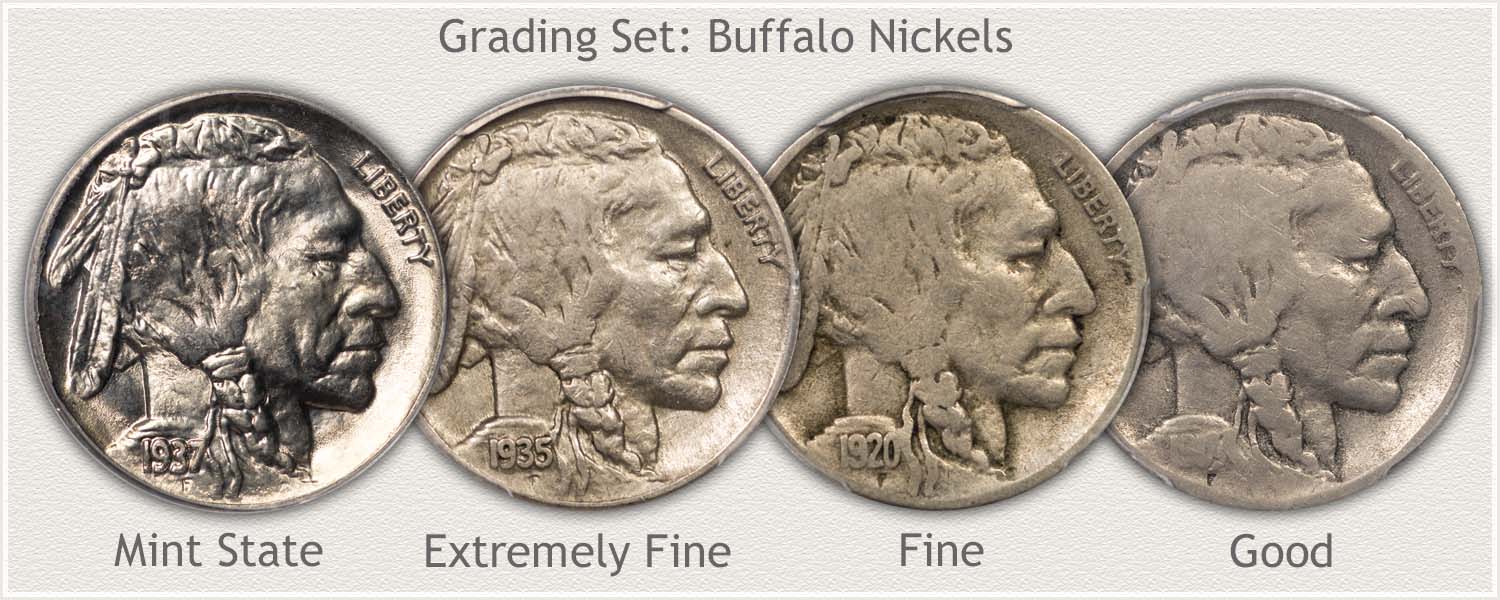
Mint State Grade: Buffalo Nickel
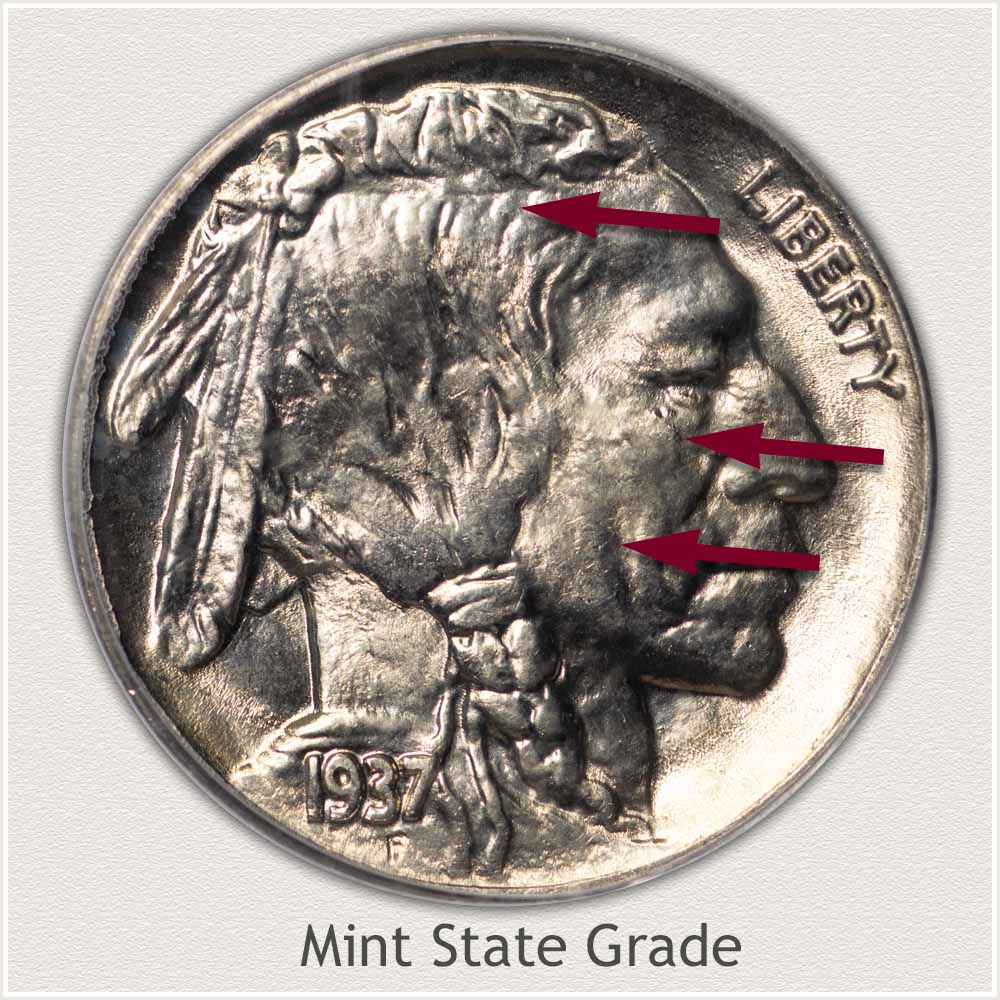
Obverse: Features Identifying Mint State Grade: A strong demand is found in old nickels meeting the Mint State grade standards. No wear to the surface is the defining factor. A few points on the coin are checked to confirm this top condition.
Just under the Indian's eye his cheek is one of the high points to design. Any wear shows as a color change to the metal and a smoothing of texture. Luster imparted during minting is a fine grain surface easily removed when worn. Judge the surface of the cheek to match surrounding areas.
View the hair along the parting line from his forehead to bow holding the feathers. High and low areas representing lines of hair remain without any smoothing. Expanding upward and below the part line all surfaces are similar in texture.
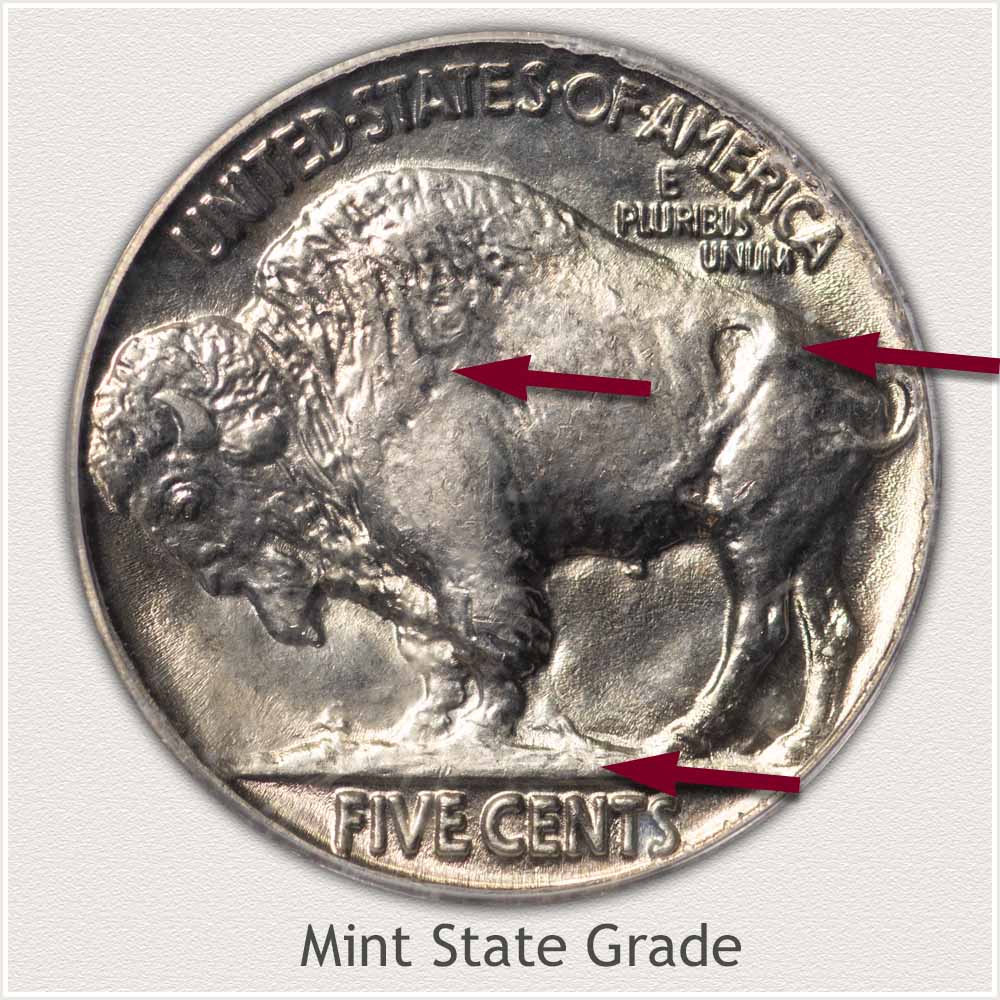
Reverse: Features Identifying Mint State Grade: High areas of the buffalo's fur are inspected to detect any wear.
Along the upper shoulder where the fur meets the back remains with a luster indicating a mint state coin.
In the hip area, any wear causes a flattening of the profile and smoothness to the metal.
Look close at the lower edge of the ground, just above "Five Cents". The ground surface and a defining lower line remains without flattening.
Extremely Fine Grade: Buffalo Nickel
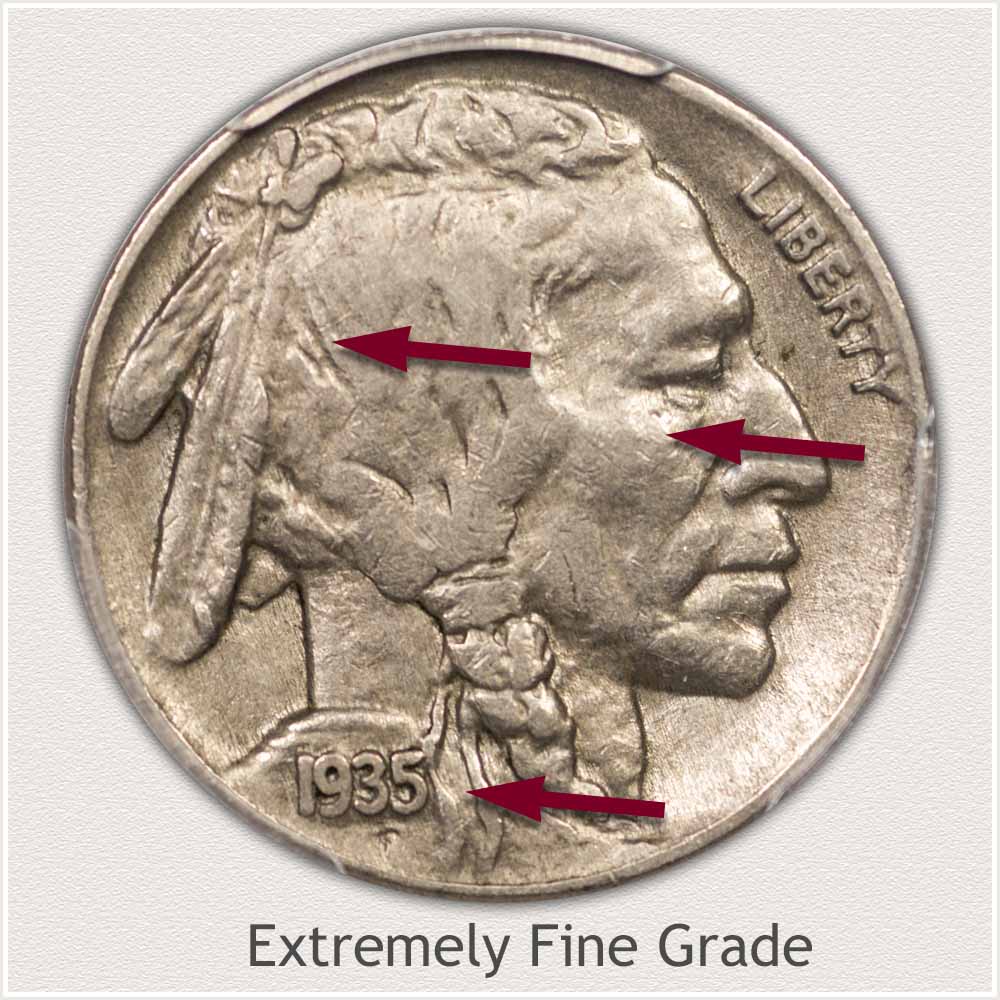
Obverse: Features Identifying Extremely Fine Grade: A bold date, fully raised is a defining feature of the Extremely Fine grade.
All digits of the date are clear and well raised. Last digit of date is fully separated from the trailing end of the tie holding the braid of hair.
A small area of flatness is confined to just under the eye. A contour remains with no flat area connecting with the hair left of the eye.
Strands of hair remain bold throughout, blending with the feather is minimal.
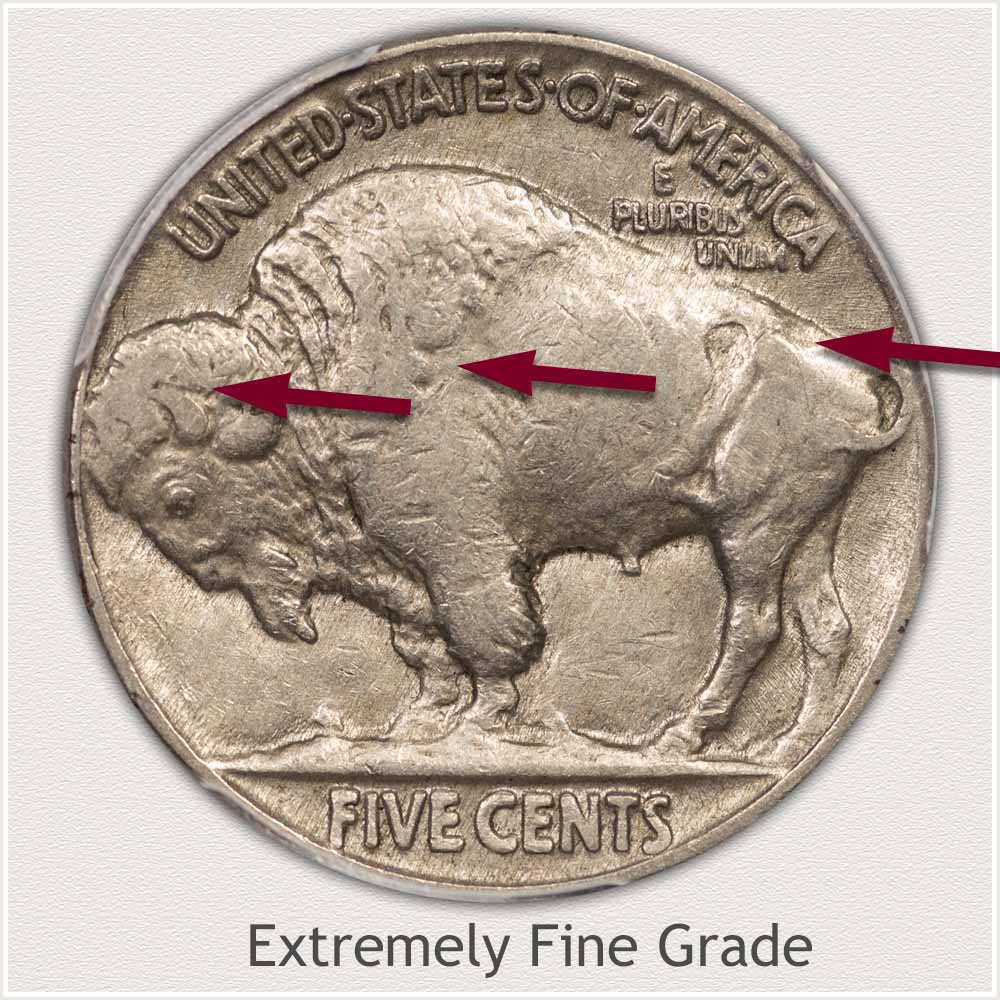
Reverse: Features Identifying Extremely Fine Grade: Overall most of the fur details remain. Light wear has flattened only the upper areas of fur.
A distinct line remains separating the buffalo's back with the line of fur along the upper leg to the upper back.
Contour remains on the hip with a noticeable raise area defined. Flatness is limited to the forward area of leg.
The majority of the buffalo's horn is visible. On well struck examples the horn is complete with the tip well defined. Helping define the grade is areas of flatness are small and disconnected.
Fine Grade: Buffalo Nickel
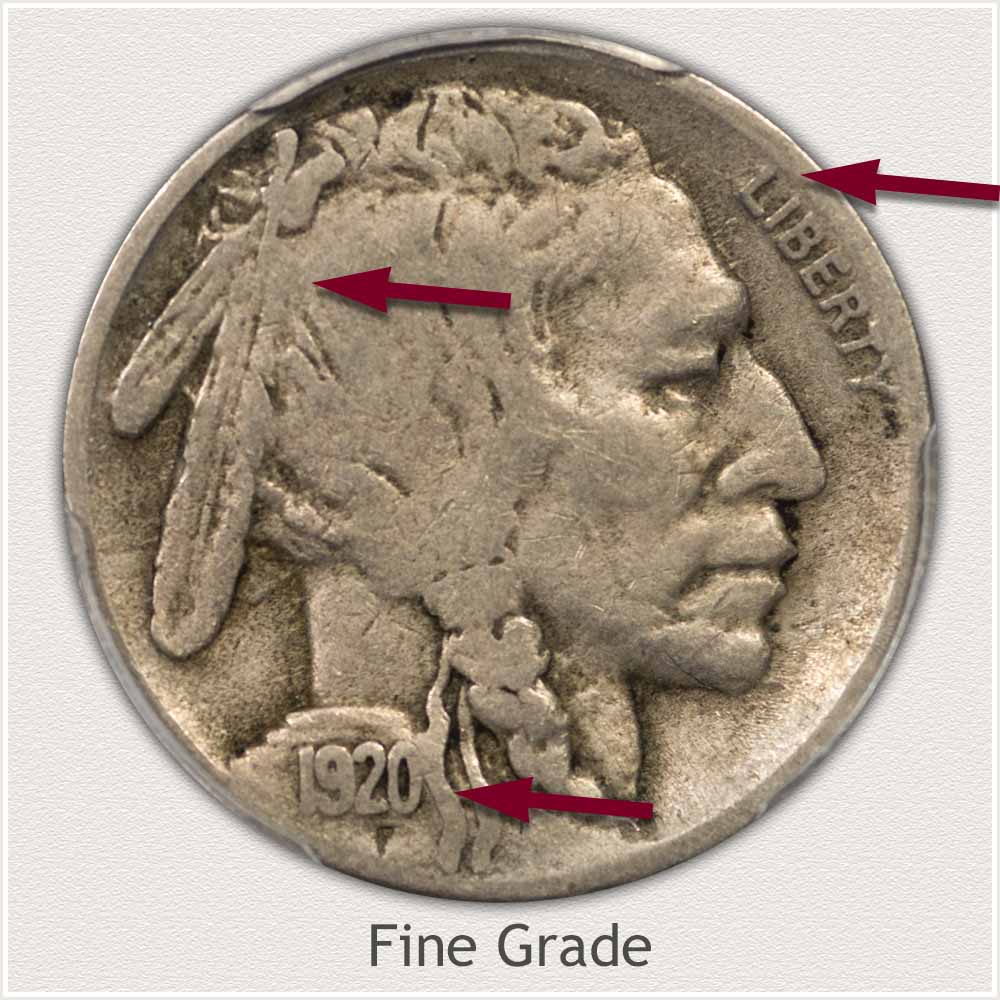
Obverse: Features Identifying the Fine Grade: Heavy wear has begun to create large areas of flatness to the surface, placing the coin in Fine grade.
First to judge is the date. Although worn to a shallow profile, all digits must show. Each number is complete. The "one" is often very weak at the bottom, but is separate from the "nine".
The long feather at the back of the head is only just beginning to merge with the Indian's hair. A line of separation is evident but faint.
Letters of "Liberty" are faint. The majority of the tops of the letters are very weak and beginning to touch the rim. A complete separation indicates a strong Fine grade.
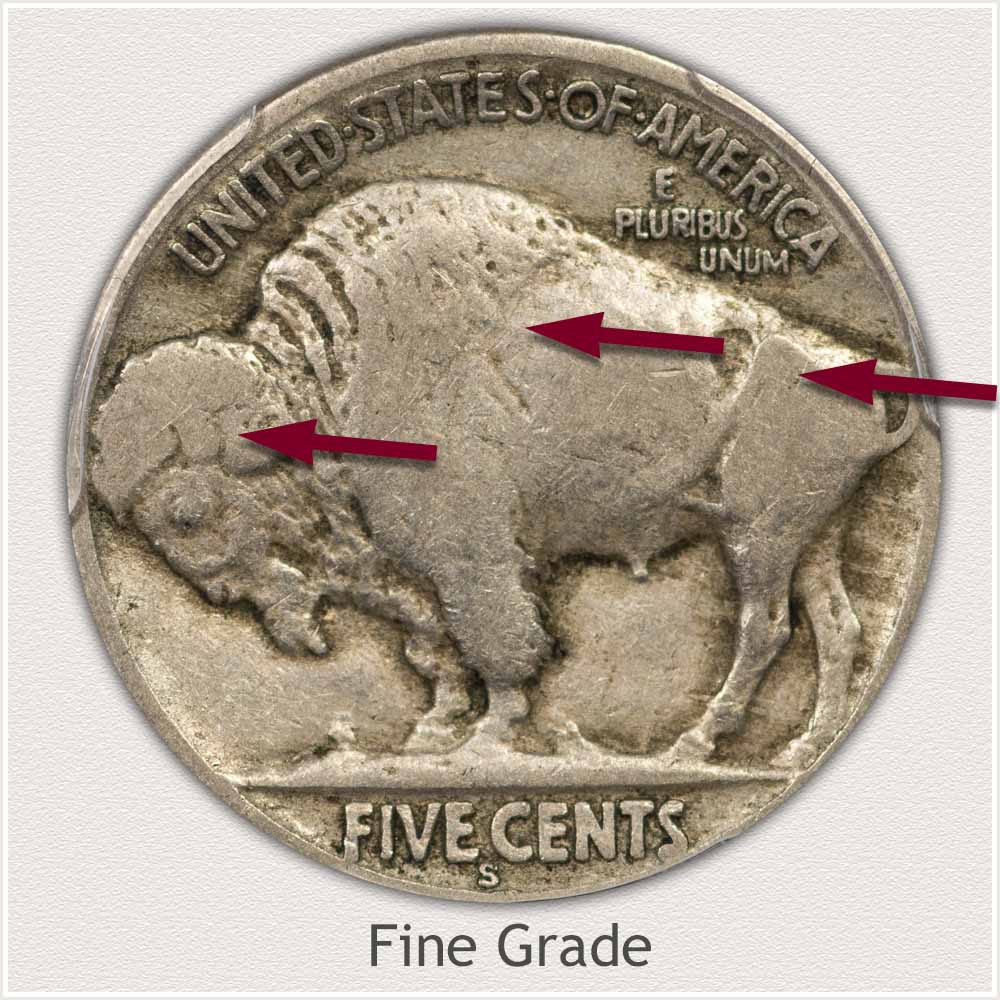
Reverse: Features Identifying the Fine Grade: Evidence of a horn remaining helps identify the Fine grade. The upper half of the horn is missing, however, a strong base to the horn is visible.
A defining line remains indicating the fur from the back of the buffalo.
Flattened areas of the head, shoulder, stomach, and hip are evident but no areas are connecting. A wide space remains identifying each design feature.
Good Grade: Buffalo Nickel
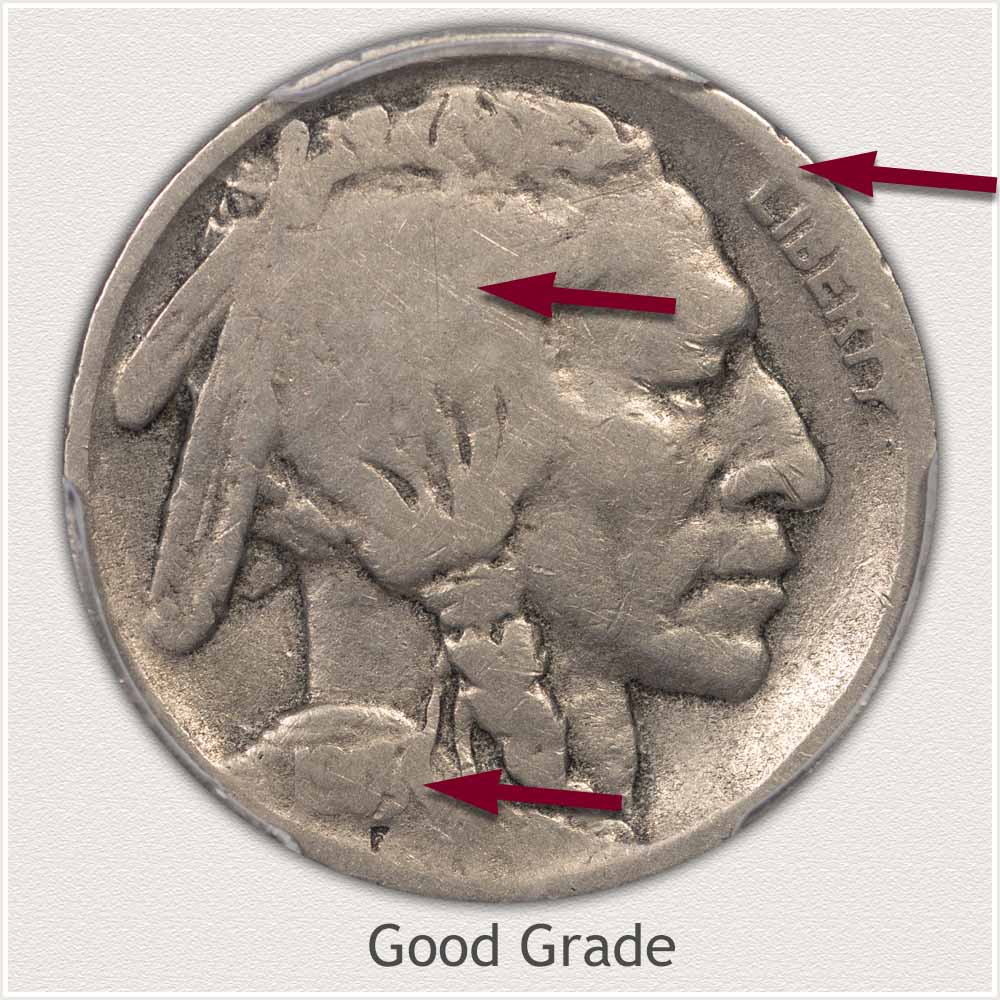
Obverse: Features Identifying the Good Grade: A date is readable but very faint. Defining the grade is the first digits "19" are readable. The "19" are merging with each other but enough remains to identify. Last two digits of date are better defined. A small raised area of all digits is always visible.
Hair detail is missing throughout the center portion above the braid. Flatness extends upward to the part in the hair.
"Liberty" is readable but fully connected with the rim. Often upper part of letters are very faint to missing.
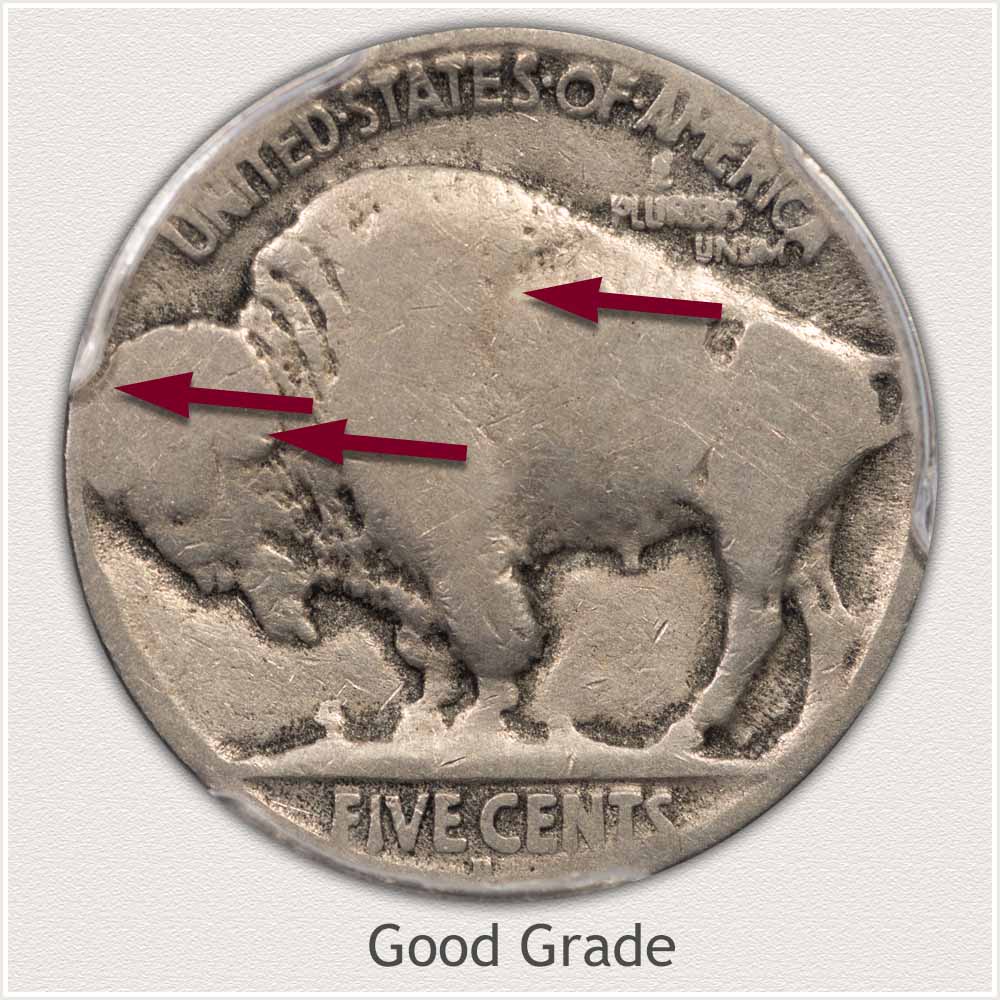
Reverse: Features Identifying the Good Grade: A once fully profiled buffalo is now flat.
The buffalo's head is missing the majority of his horn; a small base is sometimes seen. All fur detail to the head is one flat area.
A small connection of the buffalo's head to the rim is noted.
Only a slight definition of contour remains separating head, shoulder, stomach, and hip. Wide areas of flatness are now larger than contoured areas. Overall a buffalo nickel in Good grade remains with a bold outline of both the Indian and buffalo.
How to Video: Grading Buffalo Nickels
Today, dealers and collectors are searching to find, and have the funds to buy well preserved coins. Your buffalo nickel value increases dramatically the better condition of your coin. A step by step video highlights the elements to the grades.
Grading Buffalo Nickels - How to Video and Descriptions
Step 3: | Special Qualities Enhancing Value
The beginning of the Buffalo nickel series saw the year 1913 struck with two different reverse varieties.
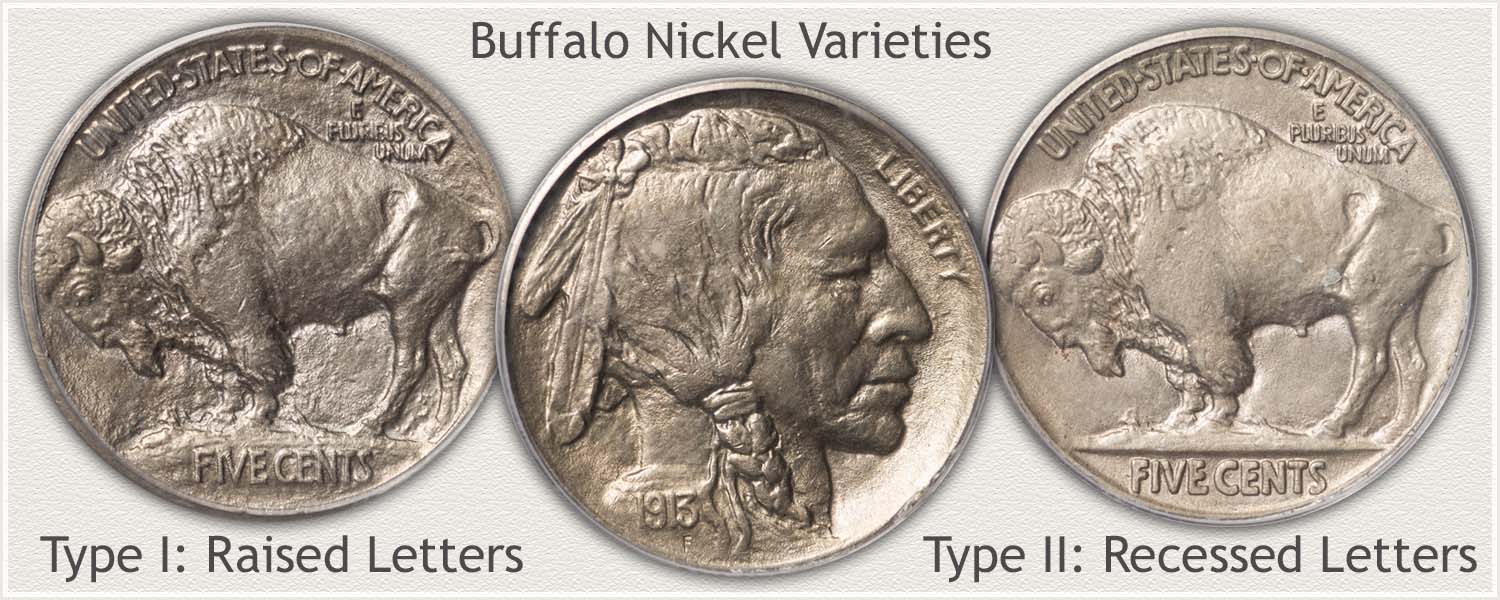
First variety: 1913 Type I portrays the buffalo standing on a mounded surface. Lettering of "Five Cents" is placed bold in the design across the mound. This raised lettering was determined unsatisfactory, quick to wear and loose the statement of denomination.
Second variety: 1913 to 1938 Type II A modification to the design recessed the lettering of "Five Cents" within the mound below the buffalo. A distinct change protecting both the denomination and mintmark. This Type II reverse design continued until the end of the series in 1938. Both Type I and Type II nickels were minted at all three mints, Philadelphia, Denver, and San Francisco and valued individually.
Designer's Initial
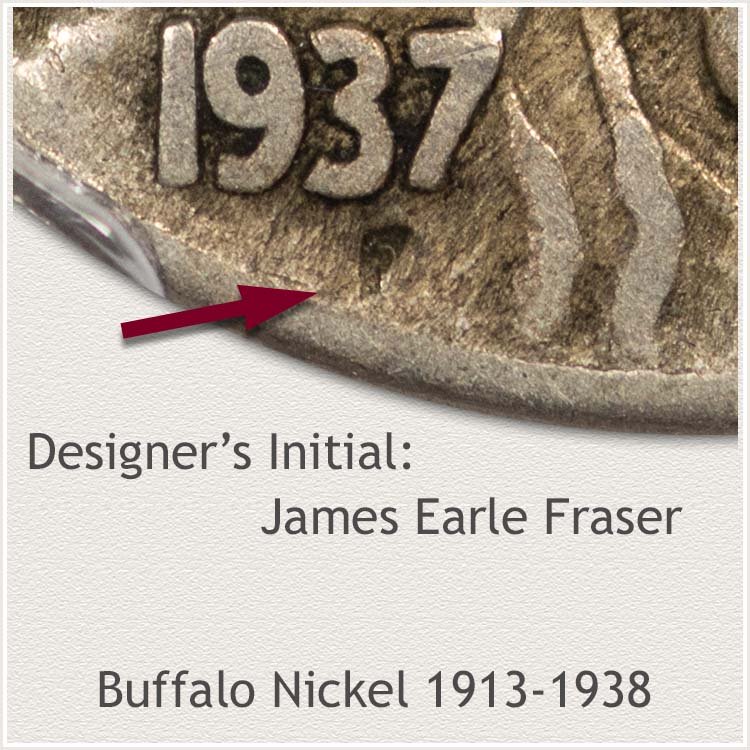
James Earle Fraser designed both the Indian obverse and Buffalo reverse. His initial "F" is found under the date of all Buffalo nickels.
Below Collector Quality
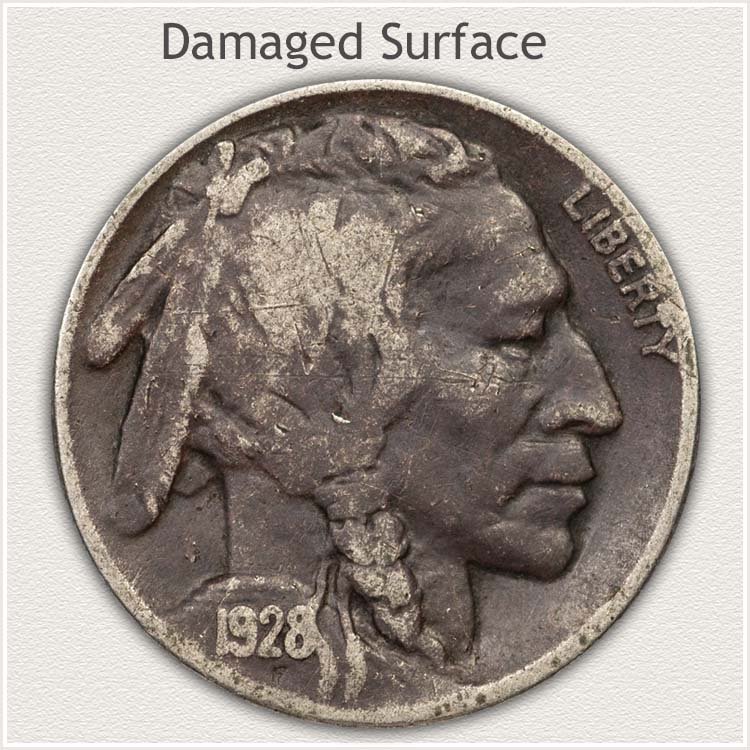
Discoloration has taken over the "look" of this nickel. Unfortunately, an abrasive was used to remove some of the color to brighten the surface. The resulting unnatural appearance has lowered value. A collector passes on these damaged coins. Damage to the surface and cleaning has removed collectability.
Detecting a Faded Date Buffalo Nickel
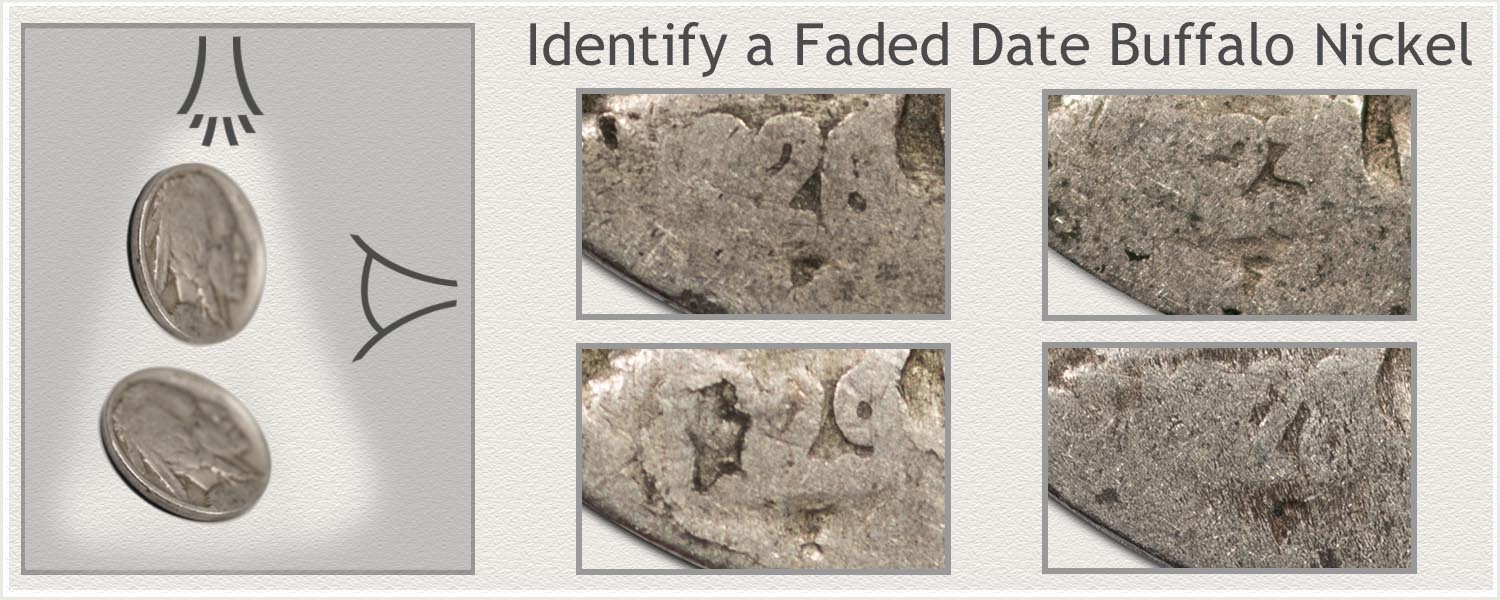
Buffalo nickels are a high relief design. Most elements sit well above the field of the coin, including the date. The shoulder of the Indian is raised and date is on top, placing it as one of the highest areas on the surface. Closest protection to the date is the rim below and knot in hair braid above. Many surviving nickels have partial dates. The "19" of the date often wears away first leaving just faint impressions of the last two digits.
Using a single, bright light and adjusting the angle of the coin to the light helps identify a faint digit or two. Magnification is almost a must to use. Many times, the decade digit is just visible, a difference in the "1" | "2" | "3" is recognizable. A faint year digit is usually the difficult one to see. Slowly tilt the angle to the light to bring out subtle detail. If identity of date is uncertain the coin is falling below the Good grade and value.
References
US Mint. 1938 US Mint Annual Report
https://nnp.wustl.edu/library/book/514142
US Mint. Catalogue of Coins of the United States
https://nnp.wustl.edu/library/book/554591
Coin Values | CoinStudy Articles
Date by Date
In Depth Buffalo Nickel Value
1913 to 1938
Buffalo Nickels are very popular. The price of lower grade coins makes it easy for younger collectors to start and enjoy collecting the series.
They are attractive in their design and price, giving them a value boost. Return and keep pace with your rising buffalo nickel value.
Old Coin Values Using a Step by Step Method
A step by step method is used to discover old coin values. Beginning with identifying important dates and mintmarks. Next comparing your coin to images to judge and determine its condition and recognize its "grade". Value charts narrow how much coins are worth.
The index page helps identify the Shield, Liberty, Buffalo, Jefferson and Three Cent Nickels. Discover the value of your old nickels by matching your coins to the grading images and value charts.
Grading Buffalo Nickels - How to Video and Descriptions
Visit the in-depth Buffalo nickel grading video, combined with enlarged images and detailed descriptions describing the differences between grades. Dates and mintmarks are only part of old nickel value. Follow the steps to grading Buffalo nickels and it leads to how much your coins are worth… accurately.
Grading Old Nickels || Video Series
Videos, close-up images and descriptions, give insight into the details to accurately grade the condition of your old nickels. Individual series covered: Shield, Liberty, Buffalo, and Jefferson nickels. Judge carefully to find the true potential value.
Do you have other denominations?
Coin Value Guide | How to Value a Coin Collection
A step by step method combined with the coin value online guide identifies how to value a coin collection. Discover how much your box of old coins is worth.
Selling Coins | How to Get the Best Value
Selling coins for the highest price is achieved with planning. Research and organize well, value your coins accurately, and then finding and selling to the right buyer equals excellent results.
★ Coin Values Discovery finds Buffalo Nickel Value and...
All old US coin values. Follow an image index to identify all US coin series, from Cents to Gold. Value charts, grading images and a step by step procedure uncovers how much your box of old coins is worth.
